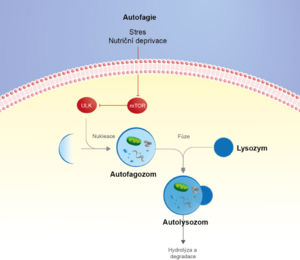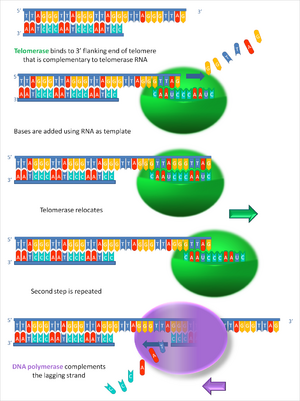Autophagy, Hayflick's limit, telomerase
A cell for immortality needs to meet three conditions:
- They must divide, diluting non-degradable proteins, or be asleep in a hypoxic environment.
- Must have telomerase.
- It must not have any (or must be turned off) mitochondria, as specialized postmitotic nerve cells and heart and skeletal muscle cells age the most.
However, cell immortality would still be only biological. Because neurons and their pathways would be restored, memory, personality, and other similar characteristics could not be preserved.
Autofagie[edit | edit source]
Autophagy is a lysosome-dependent intracellular degradation pathway in which cytoplasmic components (proteins and organelles) are delivered to lysosomes for breakdown and recycling, especially during nutrient deprivation and cellular stress. It is used to remove unnecessary proteins and organelles. We distinguish between 3 different types: macroautophagy- cytoplasmic material is enclosed in a double-membrane '''autophagosome''', which then fuses with a lysosome (autolysosome)., microautophagy- direct invagination of the lysosomal membrane engulfs cytosolic components.. and the last type is chaperones mediated selective transport of proteins by chaperone and lysosomal receptors to lysosomes where KFERQ proteins are eliminated. The last type is the so-called "abnormal autophagy", which leads to apoptosis. Autophagy has physiological roles such as adaptation to starvation (recycling amino acids and fatty acids for energy), removal of damaged organelles (e.g., '''mitophagy''') and cell homeostasis and stress response. The clinical relevance comes into play when there is dysregulated or impaired autophagy, which then leads to diseases (e.g., neurodegeneration with accumulation of protein aggregates) and cancer.
Hayflick's limit[edit | edit source]
The Hayflick limit sets the maximum number of divisions a cell goes through before its extinction. Human fibroblasts in culture can divide a maximum of 50-70 times, then age and die. The Hayflick limit applies to all somatic cells, but does not apply to tumor cells. It also depends on the current age of the cell and the (non) presence of telomerase; for cells isolated from the elderly, the number of divisions is smaller. Most somatic cells, especially fibroblasts and epithelial cells, never reach the Hayflick limit during their existence because it is very high.
Telomerase[edit | edit source]
Telomerase is a ribonucleoprotein with its own RNA primer that complements the ends of chromosomes during replication - it supplies repetitive sequences to the end of the helix, called telomeres. Most cells in the human body do not need telomerase because they divide little or not at all. Telomerase is present in stem, germline and activated immune cells. However, telomerase is not a recipe for immortality either, although mouse somatic cells have it, mice still live shorter than humans, but experimental knockout of the mouse telomerase gene has led to premature aging.
Links[edit | edit source]
Related Articles[edit | edit source]
- Difference between average and maximum life expectancy. Gene influence, theory of antagonistic pleiotropy, current possibilities of lifestyle influence: caloric restriction, physical activity, diet composition.
- Biochemical basis of aging of the organism. Radical / mitochondrial theory, aging as a catabolic failure, relation to chronic inflammation
- DNA replication
- Replicative Aging
Source[edit | edit source]
- ws:Autofagie, Hayflickův limit, telomeráza
- ALBERTS, Bruce, et al. Molecular Biology of the Cell. 6. edition. New York: Garland Science, 2015. ISBN 978-0-8153-4432-2. AbeBooks
- KUMAR, Vinay, Abul K. ABBAS and Jon C. ASTER. Robbins Basic Pathology. 11. edition. Philadelphia: Elsevier, 2024. ISBN 978-0-323-79018-5. Elsevier Shop
- KUMAR, Vinay, Abul K. ABBAS and Jon C. ASTER. Robbins & Cotran Pathologic Basis of Disease. 11. edition. Philadelphia: Elsevier, 2025. ISBN 978-0-443-28393-2. Google Books
- KLIONSKY, Daniel J., et al. Guidelines for the use and interpretation of assays for monitoring autophagy [online]. Autophagy, 2016. [cited 19/12/2025]. Available from: https://www.zora.uzh.ch/entities/publication/ebbeb39a-b541-4d73-bc3a-dcd7f6862e91 zora.uzh.ch
- BEJARANO, Eduardo and Ana Maria CUERVO. Chaperone-mediated autophagy [online]. Methods in Molecular Biology, 2010. [cited 19/12/2025]. Available from: https://pubmed.ncbi.nlm.nih.gov/20160146/
| „ | {{{1}}} | “ |


